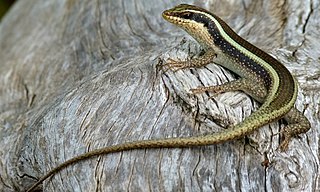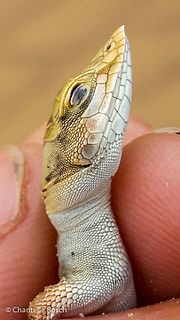Eumecia is a genus of skinks found in Sub-Saharan Africa.
Lubuya is a genus of skinks, lizards in the family Scincidae. The genus contains one species, Lubuya ivensii, known commonly as Ivens's skink, Ivens's water skink, or the meadow skink, which is endemic to Southern Africa.
Melanoseps is a genus of lizards, known commonly as limbless skinks, in the family Scincidae. The genus is endemic to Sub-Saharan Africa.
Sepsina is a genus of skinks. The genus is endemic to southern Africa.
José Alberto de Oliveira Anchieta was a 19th-century Portuguese explorer and naturalist who, between 1866 and 1897, travelled extensively in Portuguese Angola, Africa, collecting animals and plants. His specimens from Angola and Mozambique were sent out to Portugal, where they were later examined by several zoologists and botanists, chiefly among them J.V. Barboza du Bocage.

Acontias percivali, also known commonly as Percival's lance skink, Percival's legless lizard, and the Tanzanian legless lizard, is a species of small, legless (snake-like) lizard in the family Scincidae. The species is endemic to Africa.

Bitis heraldica is a venomous viper species endemic to Angola. It is easily distinguished from B. caudalis by its heavily speckled belly and lack of any supraocular "horns". No subspecies are currently recognized.

Python anchietae is a nonvenomous python species endemic to southern Africa. According to Donald George Broadley (1990), this species is most closely related to the ball python of western Africa, and no subspecies are currently recognized. It is named after the Portuguese naturalist and explorer José Alberto de Oliveira Anchieta.

The African striped skink, commonly called the striped skink, is a species of lizard in the skink family (Scincidae). The species is widespread in East Africa and Southern Africa. It is not a close relation to the Australian striped skink, Ctenotus taeniolatus.

Anchieta's cobra, sometimes referred to as the Angolan cobra, is a species of venomous snake in the family Elapidae. The species is native to Southern Africa.
Trachylepis bayonii, also known commonly as Bayão's skink, Bayon's mabuya, and Bayon's skink, is a species of lizard in the family Scincidae. The species is endemic to Africa. There are two subspecies.
Monopeltis is a genus of amphisbaenians in the family Amphisbaenidae. Species in the genus are commonly known as worm lizards, even though they are not lizards. The genus is endemic to southern Africa. 19 species are placed in this genus.

Agama anchietae, also known commonly as Anchieta's agama and the western rock agama, is a species of lizard in the family Agamidae. The species is native to southern Africa.

Monopeltis anchietae, also known commonly as Anchieta's worm lizard, Anchieta's spade-snouted worm lizard, and the Angolan spade-snouted worm lizard, is a species of amphisbaenian in the family Amphisbaenidae. The species is native to southern Africa.

The shovel-snouted lizard, also known commonly as Anchieta's desert lizard, Anchieta's dune lizard and the Namib sand-diver, is a species of lizard in the family Lacertidae. The species is native to southern Africa.

Panaspis wahlbergii, also known commonly as the Angolan snake-eyed skink, the savannah lidless skink, and Wahlberg's snake-eyed skink, is a species of lizard in the family Scincidae. The species is indigenous to Sub-Saharan Africa.

Mochlus sundevallii, also known commonly as Peters' eyelid skink, Peters' writhing skink, and Sundevall's writhing skink, is a species of lizard in the family Scincidae. The species is endemic to Sub-Saharan Africa.

Trachylepis bocagii, also known commonly as Bocage's skink, is a species of lizard in the family Scincidae. The species is native to southern Africa.
Sepsina bayonii, also known commonly as Bayon's skink, is a species of lizard in the family Scincidae. The species is native to Central Africa and Southern Africa.
Typhlacontias punctatissimus, also known commonly as the dotted blind dart skink, the speckled burrowing skink, and the speckled western burrowing skink, is a species of lizard in the family Scincidae. The species is native to southern Africa. Three subspecies are recognized.











